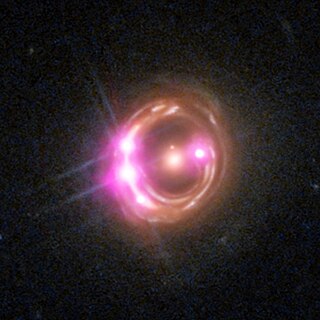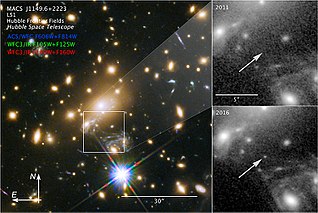Related Research Articles

In physics, a redshift is an increase in the wavelength, and corresponding decrease in the frequency and photon energy, of electromagnetic radiation. The opposite change, a decrease in wavelength and increase in frequency and energy, is known as a blueshift, or negative redshift. The terms derive from the colours red and blue which form the extremes of the visible light spectrum. The main causes of electromagnetic redshift in astronomy and cosmology are the relative motions of radiation sources, which give rise to the relativistic Doppler effect, and gravitational potentials, which gravitationally redshift escaping radiation. All sufficiently distant light sources show cosmological redshift corresponding to recession speeds proportional to their distances from Earth, a fact known as Hubble's law that implies the universe is expanding.

A gravitational lens is matter, such as a cluster of galaxies or a point particle, that bends light from a distant source as it travels toward an observer. The amount of gravitational lensing is described by Albert Einstein's general theory of relativity. If light is treated as corpuscles travelling at the speed of light, Newtonian physics also predicts the bending of light, but only half of that predicted by general relativity.

The cosmic distance ladder is the succession of methods by which astronomers determine the distances to celestial objects. A direct distance measurement of an astronomical object is possible only for those objects that are "close enough" to Earth. The techniques for determining distances to more distant objects are all based on various measured correlations between methods that work at close distances and methods that work at larger distances. Several methods rely on a standard candle, which is an astronomical object that has a known luminosity.

An Einstein ring, also known as an Einstein–Chwolson ring or Chwolson ring, is created when light from a galaxy or star passes by a massive object en route to the Earth. Due to gravitational lensing, the light is diverted, making it seem to come from different places. If source, lens, and observer are all in perfect alignment (syzygy), the light appears as a ring.

The Twin Quasar, was discovered in 1979 and was the first identified gravitationally lensed double quasar, not to be confused with the first detection of light deflection in 1919. It is a quasar that appears as two images, a result from gravitational lensing.
Tests of general relativity serve to establish observational evidence for the theory of general relativity. The first three tests, proposed by Albert Einstein in 1915, concerned the "anomalous" precession of the perihelion of Mercury, the bending of light in gravitational fields, and the gravitational redshift. The precession of Mercury was already known; experiments showing light bending in accordance with the predictions of general relativity were performed in 1919, with increasingly precise measurements made in subsequent tests; and scientists claimed to have measured the gravitational redshift in 1925, although measurements sensitive enough to actually confirm the theory were not made until 1954. A more accurate program starting in 1959 tested general relativity in the weak gravitational field limit, severely limiting possible deviations from the theory.

Gravitational microlensing is an astronomical phenomenon caused by the gravitational lens effect. It can be used to detect objects that range from the mass of a planet to the mass of a star, regardless of the light they emit. Typically, astronomers can only detect bright objects that emit much light (stars) or large objects that block background light. These objects make up only a minor portion of the mass of a galaxy. Microlensing allows the study of objects that emit little or no light.

OGLE-2005-BLG-390Lb is a super-Earth ice exoplanet orbiting OGLE-2005-BLG-390L, a star 21,500 ± 3,300 light-years from Earth near the center of the Milky Way, making it one of the most distant planets known. On January 25, 2006, Probing Lensing Anomalies NETwork/Robotic Telescope Network (PLANET/Robonet), Optical Gravitational Lensing Experiment (OGLE), and Microlensing Observations in Astrophysics (MOA) made a joint announcement of the discovery. The planet does not appear to meet conditions presumed necessary to support life.

The Optical Gravitational Lensing Experiment (OGLE) is a Polish astronomical project based at the University of Warsaw that runs a long-term variability sky survey (1992–present). The main goals are the detection and classification of variable stars, discovery of microlensing events, dwarf novae, and studies of the structure of the Galaxy and the Magellanic Clouds. Since the project began in 1992, it has discovered a multitude of extrasolar planets, together with the first planet discovered using the transit method (OGLE-TR-56b) and gravitational microlensing. The project has been led by professor Andrzej Udalski since its inception.
OGLE-2003-BLG-235L (MOA-2003-BLG-53L) is a star in the constellation of Sagittarius. The first gravitational microlensing event for which a planet orbiting the lens was detected around this star. The event occurred in during July 2003. Two groups observed and independently detected the event: the Optical Gravitational Lensing Experiment (OGLE) and the Microlensing Observations in Astrophysics (MOA), hence, the double designation. It is an orange dwarf star of spectral type K, which is accompanied by a giant planet.
In classical theories of gravitation, the changes in a gravitational field propagate. A change in the distribution of energy and momentum of matter results in subsequent alteration, at a distance, of the gravitational field which it produces. In the relativistic sense, the "speed of gravity" refers to the speed of a gravitational wave, which, as predicted by general relativity and confirmed by observation of the GW170817 neutron star merger, is equal to the speed of light (c).

The Cloverleaf quasar is a bright, gravitationally lensed quasar. It receives its name because of gravitational lensing spitting the single quasar into four images.
The Microlensing Follow-Up Network is an informal group of observers who monitor high magnification gravitational microlensing events in the Milky Way's Galactic Bulge. Its goal is to detect extrasolar planets via microlensing of the parent star by the planet. μFUN is a follow-up network - they monitor microlensing events identified by survey groups such as OGLE and Microlensing Observations in Astrophysics (MOA).
MOA-2009-BLG-387Lb is an exoplanet in the orbit of the red dwarf MOA-2009-BLG-387L. Its discovery was announced on February 21, 2011, making it the eleventh planet discovered using gravitational microlensing. The planet is thought to be over twice the mass of Jupiter and to have an orbit 80 percent larger than that of Earth's, lasting approximately 1,970 days. However, its exact characteristics are difficult to constrain because the characteristics of the host star are not well known.
MOA-2010-BLG-477L is a star whose existence was detected when it caused a microlensing event in August, 2010. The microlensing event also revealed the existence of a planet orbiting the star. At first the star was thought to be about 0.67 times the mass of the Sun, in the main-sequence phase of its stellar evolution. But by the time the star should have been separated enough in the sky from the source star of the microlensing event it was not detected, implying that it is actually a dim white dwarf star.

RX J1131-1231 is a distant, supermassive-black-hole-containing quasar located about 6 billion light years from Earth in the constellation Crater.
In astronomy, the MACHO Project was an observational search during 1992-1999 for dark matter around our Milky Way galaxy in the form of hypothetical Massive Compact Halo Objects (MACHOs), using the method of gravitational microlensing. It was one of three first-generation microlensing searches started in the early 1990s, the others being the independent EROS and OGLE projects. The MACHO project was carried out by a team of US and Australian astronomers; observations used the 1.27-metre (50-inch) telescope at the Mount Stromlo Observatory near Canberra, which was dedicated to the project full-time from 1992 until 1999. The project did not solve the dark matter problem, but placed important upper limits on the fraction of dark matter in MACHOs across a wide range of masses, and achieved several notable discoveries in the field of microlensing, and new results on several classes of variable stars.
FOCAL is a proposed space telescope that would use the Sun as a gravity lens. The gravitational lens effect was first derived by Albert Einstein, and the concept of a mission to the solar gravitational lens was first suggested by professor Von Eshleman, and analyzed further by Italian astronomer Claudio Maccone and others.

MACS J1149 Lensed Star 1, also known as Icarus, is a blue supergiant star observed through a gravitational lens. It is the seventh most distant individual star to have been detected so far, at approximately 14 billion light-years from Earth. Light from the star was emitted 4.4 billion years after the Big Bang. According to co-discoverer Patrick Kelly, the star is at least a hundred times more distant than the next-farthest non-supernova star observed, SDSS J1229+1122, and is the first magnified individual star seen.

A solar gravitational lens or solar gravity lens (SGL) is a theoretical method of using the Sun as a large lens with a physical effect called gravitational lensing. It is considered one of the best methods to directly image habitable exoplanets.
References
- ↑ Evans, N.W. (2003). "The First Heroic Decade of Microlensing". arXiv: astro-ph/0304252 .
- ↑ Bennett, D.P. (1998). "Magellanic Cloud Gravitational Microlensing Results: What Do They Mean?". Physics Reports . 307 (1–4): 97–106. arXiv: astro-ph/9808121 . Bibcode:1998PhR...307...97B. doi:10.1016/S0370-1573(98)00077-5. S2CID 1058431.
- ↑ Einstein, A. (1936). "Lens-like Action of a Star by the Deviation of Light in the Gravitational Field". Science . 84 (2188): 506–507. Bibcode:1936Sci....84..506E. doi:10.1126/science.84.2188.506. JSTOR 1663250. PMID 17769014.
- ↑ See, for example, Rahvar, Sohrab; Dominik, Martin (2008). "Detecting exoplanets with the xallarap microlensing effect" (PDF). Proceedings of the Manchester Microlensing Conference: The 12th International Conference and ANGLES Microlensing Workshop — PoS(GMC8). Vol. 037. p. 37. Bibcode:2008mmc..confE..37R. doi: 10.22323/1.054.0037 .